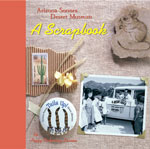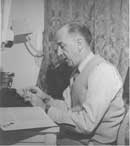
Extended Entries to the ASDM Scrapbook
William H. Carr
The desert spoke. Bill Carr listened-and acted. We have all benefited.

William H. Carr was an Easterner who came to the desert later in life, after having already completed one distinguished career. He was reared in Flushing, Long Island, an only child, whose interest in natural history was nurtured by his mother. Bill's father was a school principal, but his early and untimely death made it necessary for Bill to drop out of high school and take a job at age 17.
Bill was a dedicated Boy Scout, achieving Eagle Scout rank, and in summers worked as a nature counselor at a Scout camp in Bear Mountain. A chance meeting with Benjamin Talbot Babbitt Hyde, a man active in Scouting and an employee of the American Museum of Natural History, led in 1919 to Bill Carr's introduction to volunteer work, later as an employee in the education department of that institution.
The Museum served as Bill Carr's college and he absorbed knowledge from the museum and the scientists there, becoming a self-educated individual. Eventually he was named Associate Curator of Education for that august institution.
In 1926 after several years of working at the museum, Carr was offered an opportunity to set up an experimental outdoor educational project at Bear Mountain Park. Time would prove that the project and the man were made one for the other.
Over the next 18 years Carr devoted himself to establishing and overseeing the Nature Trails and Trailside Museums at Bear Mountain. Two miles of footpaths were laid out and along them were interspersed five small trailside museums whose exhibits interpreted the natural surroundings. These were the first facilities of their kind-an outdoor, living museum established to interpret the animals, plants, and geology of a specific area-and are the oldest such facility continuously in use.
Bill later wrote of that experience, "I learned first-hand, and not without pain, every lesson then available of attracting, educating, and dealing with the pubic that visits or patronizes museum and nature exhibitions." Those lessons would serve him well in Tucson.
Suffering from poor health, Bill was advised to seek a drier climate. He left his treasured Bear Mountain and, having been impressed by a magazine article he read about Tucson, in 1944 he moved to the desert with, as he later described it, "four suitcases and $400."
Bill had been a prolific author of natural history articles and he continued to write these, established a small bookshop dealing in rare natural history, science, and southwestern history books, and became active in local environmental causes. Carr later wrote that having arrived in Tucson, "From the first I was enchanted by the desert, yet struck by what seemed a gross lack of knowledge about it among the local populace as well as on the national level." He saw the need for an institution similar to Bear Mountain, but did not have the financial means to implement his ideas.
A fortuitous meeting of Carr and Arthur Pack in 1951, and Pima County's quandary regarding use of the Mountain House property in Tucson Mountain Park, opened the way to the founding of the Arizona-Sonora Desert Museum driven by the initiative of Carr and Pack. Thus was the next phase of Bill Carr's career in outdoor education launched.
The Arizona-Sonora Desert Museum was firmly established by September 1954 when exhaustion and ill health made it necessary for Carr to resign as Director. The following year he was able to serve as a consultant for the Museum and he was instrumental in establishing new exhibits there, including the Tunnel and Water Street, U.S.A. He served on the Museum's Board of Trustees for many years, freely advised and promoted the Museum for the remainder of his life, and carried the titles Co-Founder and Director Emeritus.
Carr and Pack teamed a second time and established the Ghost Ranch Museum, patterned along lines similar to the Desert Museum, near Abiquiu, New Mexico. It opened in 1959. For this museum Carr also bore the title of Co-Founder and Director Emeritus.
Although he never graduated from high school, Bill Carr taught the first formal college course on outdoor education at Columbia University. He was named Vice President of the Charles Lathrop Pack Forestry Foundation. He wrote more than a hundred articles and five books. The latter included "The Desert Speaks," an account of the founding and growth of the Desert Museum which went through several editions, and his longer history of the Desert Museum, "Pebbles in Your Shoes."
Carr's awards included: The American Scenic and Historic Preservation Society medal in 1938; an Honorary Life Member award from the American Forestry Association in 1959; the Distinguished Service Award from the University of Arizona; Wildlife Conservationist of the Year for the State of New Mexico in 1966; and an Honorary Life Member award from the American Museum of Natural History in 1960.
The Desert Museum's Tunnel exhibit was originated by Bill Carr and was one of his fondest achievements. Originally opened in 1957, the tunnel was a popular exhibit until 1978 when wear and tear made its closure necessary. In 1989, the renovated Tunnel was renamed "Life Underground" and dedicated to the memory of William H. Carr. Education of all those whom the Museum touched was always uppermost in Bill Carr's mind and in 1980 he was honored by establishment at the Desert Museum of the William H. Carr Interpretive Naturalist Position.
William Woodin, who helped Bill Carr establish the Museum, became Director after Carr, and worked with Bill over many years, described Bill Carr as "a man of total dedication and boundless imagination and truly a pioneer in the concept of outdoor education."
A later Desert Museum Director, Dan Davis, wrote of Carr in a memorial after his death, October 25, 1985, "Few people leave the kind of legacy Bill gave to the world. He was a true pioneer, a leader in natural history interpretation. His ideas about outdoor, regional interpretation are epitomized at the Desert Museum. Those ideas have taken hold throughout the world. Bill Carr was one of a kind."
Bill requested that his ashes be spread on the Desert Museum grounds, Phoebe Pack stated. "He used to say he wanted to rest on the museum, out in the desert, because it was a part of him."